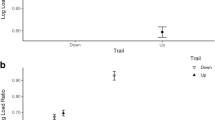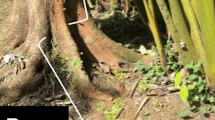Summary
Atta colombica uses chemical mass recruitment that allows the rapid exploitation of resources. Most foragers thus search only within patches. Accumulation of ‘extra’ foragers at patches results in sampling of alternate food items and area-restricted search as patch resources are depleted.
Individual workers have a higher probability of removing a leaf fragment the earlier they arrive at a bait. Workers that arrive when much of the resource is gone travel further on the bait (within the patch) but do not spend significantly more time at the patch. They ‘give up’ after 50–80s.
Foraging effort is centered on the extensive trail system, not on the nest a predicted by time and energy foraging models. Search effort is also trail centered. The probability that an item will be discovered decreases with distance from the trail and increasing litter depth. Trail traffic and trail quality together mave no significant effect although this may be because they act antagonistically.
Economic considerations predict that trials should be built to high quality and very productive sites. If trails are built as a result of recruitment and recruitment reflects patch quality and productivity, characteristics of forage sites are physically embodied in the trail system.
Leaf cutter foraging is better understood as a long term optimization that effectively exploits resources over the lifetime of the colony than as ‘prudent’ predation that ‘husbands’ resources.
Similar content being viewed by others
References
Carrol CR, Janzen D (1973) Ecology of foraging by ants. Annu Rev Ecol Syst 4:231–257
Carthy JD (1951) The orientation of two allied species of British ants. Behaviour 3:275–318
Cherrett JM (1968) The foraging behaviour of Atta cephalotes L. I. foraging pattern and plant species attacked in a tropical rain forest. J Anim Ecol 37:387–403
Cherrett JM (1972a) Some factors involved in the selection of vegetable substrate by Atta cephalotes in the tropical rain forest. J Anim Ecol 41:647–660
Cherrett JM (1972b) Chemical aspects of plant attack by leafcutting ants. In: Harbourne JB (ed) Phytochemical ecology. Academic Press, London, pp 13–24
Cherrett JM, Seaforth CE (1970) Phytochemical arrestants for the leaf-cutting ants Atta cephalotes and Acromyrmex octospinosus with some notes on the ants' response. Bull Entomol Res 59:615–625
Denslow JS (1980) Notes on the seedling ecology of a large-seeded species of Bombacaceae. Biotropical 12:220–222
Dobrzanska J (1958) Partition of foraging grounds and modes of conveying information among ants. Acta Biol Exp 18:55–67
Dobrzanska J (1966) Contribution to the ethology of Leptothorax acervorum (Hym.: Form.). Acta Biol Exp 26:71–78
Farentinos RC, Capretta PJ, Kepuer RE, Littlefield VM (1981) Selective herbivory in tassel-eared squirrels: Role of monoterpenes in Ponderosa pines chosen as feeding trees. Science 213:1273–1275
Freeland WJ, Janzen DH (1974) Strategies in herbivory by mammals: the role of plant secondary compounds. Am Nat 198:269–289
Gamboa GJ (1975) Foraging and leaf-cutting of the desert gardening ant Acromyrmex versicolor versicolor (Pergande) HF. Oecologia (Berl) 20:103–110
Hangartner W (1967) Spezifität und Inaktivierung des Spurpheromons von Lasius fuliginosos Latr. and Orientierung der Arbeiterinnen im Duftfeld. Z Vergl Physiol 57:103–136
Hangartner W (1969) Structure and variability of the individual odor trail in Solenpsis saevissima Fabr. (Hym.: Form.). Z Vergl Physiol 62:111–120
Hangartner W (1970) Control of pheromone quantity in odor trails of the ant Acanthomyops interjectus Mayr. Experientia 26:664–665
Harrison JS, Gentry JB (1981) Foraging pattern, colony distribution, and foraging range of the florida harvester ant, Pogonomyrmex badius. Ecology 62:1467–1473
Hassell MP, Southwood TRE (1978) Foraging strategies of insects. Annu Rev Ecol Syst 9:75–98
Heinrich B (1978) The economics of insect sociality. In: Krebs JR, Davies NB (eds) Behavioral ecology. Sinauer Press, Sunderland, Massachusetts
Hölldobler B (1971) Recruitment behavior in Camponotus socius. Z Vergl Physiol 75:123–142
Hölldobler B (1976) Recruitment behavior, home range orientation and territoriality in harvester ants, Pogonoyrmex spp. Behav Ecol Sociobiol 1:3–44
Hölldobler B (1977) Communication in social hymenoptera. In: Sebeok TA (ed) How animals communicate. Indiana University Press, Bloomington, Indiana, pp 418–471
Hölldobler B, Lumsden CJ (1980) Territorial strategies in ants. Science 210:723–739
Hölldobler B, Möglich M (1980) The foraging system of Pheidole militicida (Hymenoptera: Formicidae). Insectes Soc 27:237–264
Hölldobler B, Wilson EO (1970) Recruitment trails in the harvester and Progonomyrmex badius. Psyche 77:385–399
Hölldobler B, Möglich M, Maschwitz U (1974) Communication by tandem running in the ant Camponotus sericeus. J Comp Physiol 90:105–127
Holt SJ (1955) On the foraging activity of the wood ant. J Anim Ecol 24:1–34
Janzen DH (1974) Tropical blackwater rivers, animals and mastfruiting by the Dipterocarpaceae. Biotropica 6:69–103
Katz PL (1974) A long term approach to foraging optimization. Am Nat 108:758–782
Kiebs JR, Davies NB (eds) (1978) Behavioral ecology. Sinauer Press, Sunderland, Massachusetts
Möglich M, Hölldobler B (1975) Communication and orientation during foraging and emigration in the ant Formica fusca. J Comp Physiol 101:275–288
Möglich M, Maschwitz U, Hölldobler B (1974) Tandem calling: a new kind of signal in ant communication. Science 186:1046
Moser JC, Silverstein RM (1967) Volatility of trail-marking substance in the twon ant. Nature 215:206–207
Oster GF, Heinrich B (1976) Why do bumble bees major? Ecol Monogr 46:129–133
Oster GF, Wilson EO (1978) Caste and ecology in the social insects. Monogr Popul Biol 12:1–352
Rockwood LL (1973) Density, distribution and dispersion of two species of Atta (Hym.: Formicidae) in Guanacaste Province, Costa Rica. J Anim Ecol 42:803–817
Rockwood LL (1975) The effects of seasonality on foraging in two species of leaf-cutting ants (Atta) in Guanacaste Province, Costa Rica. Biotropica 7:176–193
Rockwood LL (1976) Plant selection and foraging patterns in two species of leaf-cutting ants (Atta). Ecology 57:48–61
Rosengren R (1971) Route fidelity, visual memory and recruitment behavior in foraging wood ants of the genus Formica. Acta Zool Fenn 133:1–106
Shepherd JD (1981) The foraging ecology of a tropical leaf-cutter ant, Atta colombica. PhD thesis, University of Wisconsin, Madison, Wisconsin
Smeed RJ (1967) The road capacity of city centers. Highw Res Rec 169:22–29
Smeed RJ (1968) Traffic studies and urban congestion. J Transp Econ Policy 2:33–70
Wellenstein G (1952) Zur Ernährungsbiologie der Roten Ameise (Formica rufa L.) Z Pflanzenkr Pflanzenpathol Pflanzenschutz 59:430–451
Wilson EO (1962) Chemical communication among workers of the fire ant Solenopsis saevissima (Fr. Smith) I: the organization of foraging effort. Anim Behav 10:134–147
Zach R, Falls JB (1976) Ovenbird (Aves: Parulidae) hunting behavior in a patch environment: An experimental study. Can J Zool 54:1863–1879
Author information
Authors and Affiliations
Rights and permissions
About this article
Cite this article
Shepherd, J.D. Trunk trails and the searching strategy of a leaf-cutter ant, Atta colombica . Behav Ecol Sociobiol 11, 77–84 (1982). https://doi.org/10.1007/BF00300095
Received:
Accepted:
Issue Date:
DOI: https://doi.org/10.1007/BF00300095




